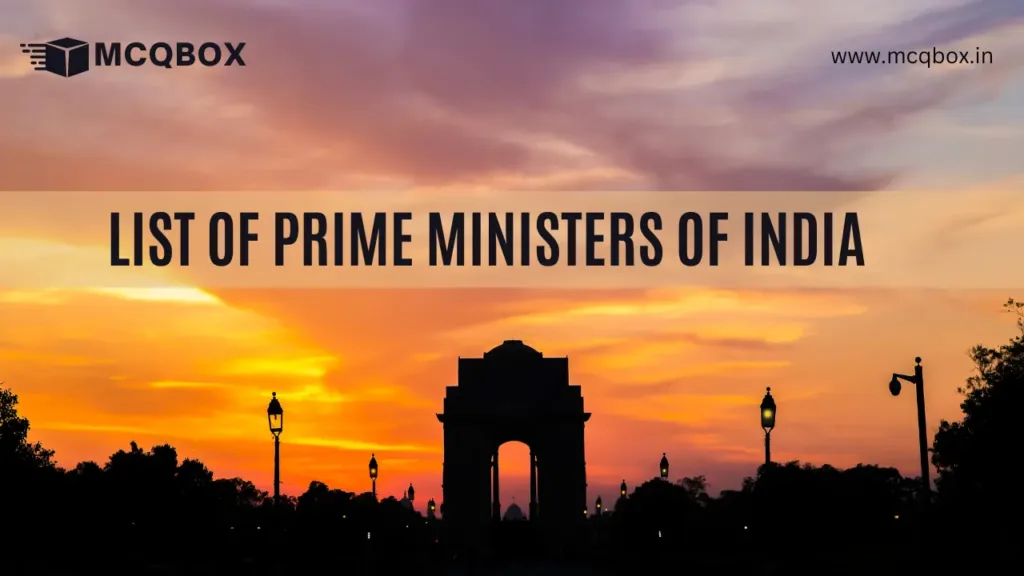Exploring the leadership journey of India through a comprehensive List of Prime Ministers of India Each leader has left a unique mark on our nation’s history.
Table of Contents

List of Prime Ministers of India
| Prime Minister | Period |
| Jawahar Lal Nehru | 15 Aug 1947 to 27-May-1964 |
| Gulzarilal Nanda | 27 May 1964 to 9 June 1964 |
| Lal Bahadur Shastri | 09-Jun-1964 to 11-Jan-1966 |
| Gulzarilal Nanda | 11-Jan-1966 to 24 January 1966 |
| Indira Gandhi | 24-Jan-1966 to 24-Mar-1977 |
| Morarji Desai | 24-Mar-1977 to 28-Jul-1979 |
| Charan Singh | 28-Jul-1979 to 14-Jan-1980 |
| Indira Gandhi | 14-Jan-1980 to 31-Oct-1984 |
| Rajiv Gandhi | 31-Oct-1984 to 02-Dec-1989 |
| Vishwanath Pratap Singh | 02-Dec-1989 to 10-Nov-1990 |
| Chandra Shekhar | 10-Nov-1990 to 21-Jun-1991 |
| P. V. Narasimha Rao | 21-Jun-1991 to 16-May-1996 |
| Atal Bihari Vajpayee | 16-May-1996 to 01-Jun-1996 |
| H. D. Deve Gowda | 01-Jun-1996 to 21-Apr-1997 |
| Inder Kumar Gujral | 21-April-1997 to 19-Mar-1998 |
| Atal Bihari Vajpayee | 19-Mar-1998 to 22-May-2004 |
| Dr. Manmohan Singh | 22-May-2004 to 26-May-2014 |
| Narendra Damodardas Modi | 26-May-2014 to Incumbent |
Narendra Modi’s Leadership (2014-Incumbent)
Narendra Modi 14th Prime Minister of India, Serving his second tenure, Modi was first elected in 2014 to the 16th Lok Sabha. His leadership has been characterized by a commitment to governance and development.
Preceding Prime Ministers
Manmohan Singh (2004-2014)
Dr. Manmohan Singh, the 13th Prime Minister, served two complete terms, heading the United Progressive Alliance (UPA) governments. Renowned for his role in the 1991 LPG reforms, he also held significant positions like the 15th Governor of the Reserve Bank of India.
Atal Bihari Vajpayee (1996, 1998-99, 1999-2004)
Atal Bihari Vajpayee, the 10th Prime Minister, served three terms and was conferred with the Bharat Ratna. A pivotal figure in bettering Indo-Pakistan ties, he played a crucial role in the Pokhran 2 nuclear tests.
Inder Kumar Gujral (1997-1998)
I.K. Gujral, the 12th Prime Minister, participated in the Quit India Movement and is remembered for the Gujral Doctrine, guiding India’s foreign policy. He held dual memberships in both the Rajya Sabha and Lok Sabha.
HD Deve Gowda (1996-1997)
Haradanahalli Doddegowda Deve Gowda, the 11th PM, served as the Karnataka Chief Minister before assuming office. His term was marked by forming a government with Congress support, showcasing his political acumen.
PV Narasimha Rao (1991-1996)
Pamulaparthi Venkata Narasimha Rao, the 10th PM, was the first from southern India. His tenure saw significant economic reforms, and he held diverse ministerial roles, contributing to India’s political and economic landscape.
Chandra Shekhar (1990-1991)
The eighth Prime Minister, Chandra Shekhar, led a minority government with Congress support, facing challenges during his tenure. The 1991 economic crisis and Rajiv Gandhi’s assassination were significant events.
VP Singh (1989-1990)
Vishwanath Pratap Singh, the seventh PM, implemented the Mandal Commission Report for reservations. A former Chief Minister of Uttar Pradesh, Singh played key roles in finance and defense under PM Rajiv Gandhi.
Rajiv Gandhi (1984-1989)
Rajiv Gandhi, the sixth PM and youngest to date. His term also saw the Bhopal gas tragedy, and he was posthumously awarded the Bharat Ratna.
Chaudhary Charan Singh (1979-80)
C. Charan Singh, the fifth PM, championed peasants’ rights and had a significant political legacy. Born in a peasant family, Singh’s contributions left a lasting impact on Indian politics.
Morarji Desai (1977-79)
The fourth Prime Minister, Morarji Desai, led the Janata Party government, focusing on governance and economic policies. A former Chief Minister of Bombay, he played a vital role in shaping post-independence India.
Indira Gandhi (1966-1977, 1980-1984)
The third PM and the first woman Prime Minister, Indira Gandhi, served the second-longest term. Her leadership during the 1971 war, imposition of the 1975 state emergency, and subsequent assassination mark her legacy.
Gulzarilal Nanda (1964, 1966)
Gulzarilal Nanda served as Acting PM in transitional periods following the deaths of Lal Bahadur Shastri and Jawaharlal Nehru. His contributions were crucial in maintaining stability during these transitions.
Lal Bahadur Shastri (1964-1966)
The second PM, Lal Bahadur Shastri, coined the slogan ‘Jai Jawan Jai Kisan’ during the 1965 Indo-Pakistan war. His leadership during that conflict and contributions to post-independence India are noteworthy.
Jawaharlal Nehru (1947-1964)
India’s first and longest-serving PM, Jawaharlal Nehru, played a leading role in the independence movement. Known as ‘Chacha Nehru,’ he left an indelible mark on the nation’s history.
FAQs
The current Prime Minister of India is Narendra Modi.
Manmohan Singh is renowned for his role in the 1991 LPG reforms and his leadership during two complete terms.
Atal Bihari Vajpayee served three terms as the Prime Minister of India.
HD Deve Gowda served as the Chief Minister of Karnataka before becoming the 11th Prime Minister of India.
Also See- Bharat Ratna Award Winner List (1954–2024)